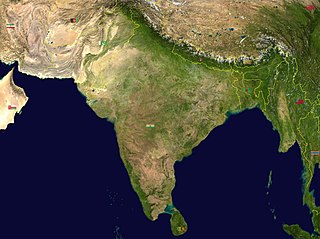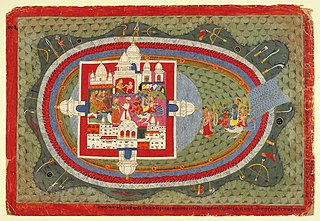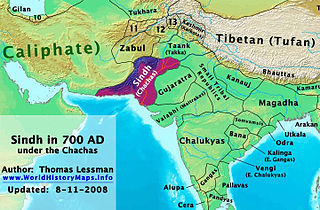 W
WThe Abhira kingdom in the Mahabharata is either of two kingdoms near the Sarasvati river. They were dominated by the Abhiras, sometimes referred to as Surabhira also, combining both Sura and Abhira kingdoms. Modern day Abhira territory lies within Northern areas of Gujarat and Southern Rajasthan, India. King Sivadatta was probably the founder of the Abhira/ahira kingdom.
 W
WAnga was an ancient Indian kingdom that flourished on the eastern Indian subcontinent and one of the sixteen mahajanapadas. It lay to the east of its neighbour and rival, Magadha, and was separated from it by the river Champa in the modern day Bhagalpur and Munger in the state of Bihar. The capital of Anga was located on the bank of this river and was also named Champa and Malini. It was prominent for its wealth and commerce. Anga was annexed by Magadha in the 6th century BCE.
 W
WAsura Kingdom was the legendary kingdom, established by Marichi, first of the kings of ruling dynasty, in the Vedic period, in area what now known as 'Sonitpur' with capital at modern 'Tezpur' in central Assam. The kingdom was contemporary of Pragjyotisha of Kamarupa. The references for the kingdom comes from Puranas, Mahabharata and other epics.
 W
WThe Republic of India has two principal short names in both official and popular English usage, each of which is historically significant, "India" and "Bharat". The first article of the Constitution of India states that "India, that is Bharat, shall be a union of states," implicitly codifying "India" and "Bharat" as equally official short names for the Republic of India. A third name, "Hindustan", is sometimes an alternative name for the region comprising most of the modern Indian states of the subcontinent when Indians speak among themselves. The usage of "Bharat", "Hindustan", or "India" depends on the context and language of conversation.
 W
WDvārakā, also known as Dvāravatī, is a sacred historic city in Hinduism, Jainism, and Buddhism. It is also alternatively spelled as Dvarika. The name Dvaraka is said to have been given to the place by Bhagwan Krishna, a major deity in Hinduism. Dvaraka is one of the Sapta Puri of Hinduism.
 W
WGandhāra was a kingdom mentioned in the Indian epics Mahabharata and Ramayana. Gandhara prince Shakuni was the root of all the conspiracies of Duryodhana against the Pandavas, which finally resulted in the Kurukshetra War. Shakuni's sister was the wife of the Kuru king Dhritarashtra and was known as Gandhari after the area of Gandhāra. Puskalavati, Takshasila (Taxila) and Purushapura (Peshawar) were cities in this Gandhara kingdom. Takshasila was founded by Raghava Rama's brother Bharata. Bharata's descendants ruled this kingdom afterwards. During the epic’s period, the kingdom was ruled by Shakuni's father Suvala, Shakuni and Shakuni's son. Arjuna defeated Shakuni's son during his post-war military campaign for Yudhishthira's Aswamedha Yagna.
 W
WIn Indian history, the Solar dynasty or the Ikshvaku dynasty was founded by the legendary king Ikshvaku. The dynasty is also known as Sūryavaṁśa and along with Lunar dynasty comprises one of the main lineages of the Kshatriya Varna. Rama belonged to the Ikshavaku dynasty. According to the Jain texts, twenty-two out of the twenty-four Jain Tirthankara belonged to this dynasty. Rishabha was the first tirthankar of Jainism. Both refers to the same person. According to Buddhist texts and tradition, Gautama Buddha descended from this dynasty. Many later kings of the Indian subcontinent claimed to be of Suryavanshi background.
 W
WThe Kambojas were a tribe of Iron Age India, frequently mentioned in Sanskrit and Pali literature. The tribe coalesced to become one of the shodhasha (sixteen) Mahajanapadas of ancient India mentioned in the Anguttara Nikaya. Duryodhana's wife Bhanumati was daughter of Kamboja King Chitrangada and Queen Chandramundra.
 W
WKīkaṭa was an ancient kingdom in what is now India, mentioned in the Vedas.
 W
WKishkindha is the kingdom of the Vanara King Sugriva, the younger brother of Vali, in the Sanskrit epic Ramayana. According to the historical account of India, this was the kingdom where Sugriva ruled with the assistance of his friend, Hanuman. This kingdom is identified to be the regions around the Tungabhadra river near Hampi in present-day Bellary district, Karnataka. The mountain near the river known as Rishimukha, where Sugriva lived with Hanuman during his exile, bears the same name.
 W
WLanka is the name given in Hindu epics to the island fortress capital of the legendary asura king Ravana in the epics of the Ramayana and the Mahabharata. The fortress was situated on a plateau between three mountain peaks known as the Trikuta Mountains. The ancient city of Lankapura is thought to have been burnt down by Hanuman. After its king, Ravana, was killed by Rama with the help of Ravana's brother Vibhishana, the latter was crowned king of Lankapura. The site of Lankā is identified with Sri Lanka. His descendants were said to still rule the kingdom during the period of the Pandavas. According to the Mahabharata, the Pandava Sahadeva visited this kingdom during his southern military campaign for the rajasuya of Yudhishthira.
 W
WMadra is the name of an ancient region and its inhabitants, located in the north-west division of the ancient Indian sub-continent. The kingdom's boundaries are believed to have extended from portions of the Hindu Kush to the present day Punjab and Haryana province of India. Some support for this belief lies within the ancient epic, the Mahabharata that describes the armies of the Madra Kingdom led by King Shalya, marching from ancient Northwest Punjab to what would be known today as Haryana. The Madra are numerously referenced in ancient Sanskrit and Pali literature and some scholarly work references them as being part of the Kshatriya group during the time of the Mahabharata. Recent scholarly work references the Madra kingdom existing for at least two thousand years and places its home between the Ravi and Chenab. The Kingdom of Madra was founded by Madra who was the son of Shibi in Treta Yuga.
 W
WMadra Kingdom was a kingdom grouped among the western kingdoms in the epic Mahabharata. Its capital was Sagala, modern Sialkot. The Kuru king Pandu's (Pāṇḍu) second wife was from Madra kingdom and was called Madri. The Pandava twins, Nakula and Sahadeva, were her sons. Madri's brother Shalya was the king of Madra. Though affectionate to the Pandavas, he was tricked to give support to Duryodhana and fought against the Pandavas during the Kurukshetra War. He was killed by Yudhishthira, the eldest Pandava. Other than the Madra kingdom with Sagala as its capital, it is believed that there was a Western Madra and a Northern Madra.
 W
WMahisha or Mahishaka was a kingdom in ancient India, ruled by the Asura king Mahisha. His capital, Mahisha City, is currently known as Mysore a city in Karnataka. This kingdom is mentioned in Mahabharata, though Puranas gives more information. The name Mahisha means great, powerful.
 W
WMushika dynasty, also spelled Mushaka, Tamil/Malayalam: Eli or Ezhi, was a minor dynastic power that held sway over the region in and around Mount Ezhi (Ezhimala) in present-day Kerala, south India. The country of the Mushikas, ruled by an ancient lineage of velir-level chieftains of the same name, appears in early historic (pre-Pallava) south India. Early Tamil poems contain several references to the exploits of Nannan of Ezhimalai. Nannan was known as a great enemy of the pre-Pallava Chera chieftains. The clan also had matrimonial alliances with the Chera, Pandya and Chola chieftains.
 W
WPragjyotisha was a mythological kingdom that later came to be associated with the historical Kamarupa.
 W
WSindhu was a kingdom of ancient India mentioned in the epic Mahabharata and in the Harivamsa Purana. It stretched along the banks of river Sindhu (Indus) in ancient India, in modern Pakistan. It is often mentioned alongside the Sauvira Kingdom. It is believed that Sindhu kingdom was founded by Vrsadarbh, one of sons of Sivi. According to the Glimpses of Ancient Sindh, authored by Mirchandani, its capital was known as Vrsadarbhpura, and Tulsianis, later known as Sindhu, was located at or near the location of the present town of Mithankot. The inhabitants of the kingdoms were called Sindhus or Saindhavas. "Sindhu" literally means "river" and "sea". According to the epic Mahabharata, Jayadratha was the king of Sindhus, Sauviras and Sivis. Probably Sauvira and Sivi were two kingdoms close to the Sindhu kingdom and Jayadratha conquered them, holding them for some period of time. Sindhu and Sauvira seem to have been two warring states fighting each other.
 W
WSuhma Kingdom was an ancient state during the Late Vedic period on the eastern part of the Indian Subcontinent, which originated in the region of Bengal. This kingdom was mentioned in the epic Mahabharata along with its neighbouring kingdom Prasuhma.
 W
WVanga was an ancient kingdom and geopolitical division on the Ganges delta in the Indian subcontinent. The kingdom is one of the namesakes of the Bengal region. It was located in southern Bengal, with the core region including present-day southern West Bengal (India) and southwestern Bangladesh. Vanga features prominently in the epics and tales of ancient India as well as in the history of Sri Lanka.
 W
WThe Vidarbha kingdom in the Sanskrit epic Mahabharata is among the many kingdoms ruled by Yadu kings . It is the southernmost kingdom within the epic's geographical horizon, south of the Vindhya range, in the region still known as Vidarbha in what is now Central India.
 W
WVirata was a kingdom ruled by the Matsya king by the name Virata. It was here that the Pandavas spent their 13th year of anonymity after their 12 years of forest-life in the forests of Kamyaka and Dwaita. Its capital was Virata Nagari, modern Bairat in the Jaipur district of Rajasthan. Akhnoor, a town in Jammu and Kashmir is also considered by some as the Virat Nagar. Upaplavya was another city in this kingdom where the Pandavas and their allies camped before the beginning of the great Kurukshetra War.
 W
WYaudheya or Yoddheya Gana was an ancient militant confederation. The word Yaudheya is a derivative of the word from yodha meaning warriors. They were principally kshatriya renown for their skills in warfare, as inscribed in the Junagadh rock inscription of Rudradaman by the Indo-Scythian ruler Rudradaman of the Western Satraps. The Yaudheyas emerged in the 5th century BCE and governed independently until being incorporated into the Maurya Empire. Following the disintegration of the Maurya Empire, the Yaudheyas regained autonomy and ruled as contemporaries to the Shunga Empire and Indo-Greek Kingdoms, and minted their own coinage. However, they were conquered by the Kshatraps led by Rudradaman, and although briefly winning independence, they were then annexed by the Kushan Empire under Kanishka. The Yaudheya Republic reformed and flourished up to the middle to the 4th century when it was ultimately conquered by Samudragupta and incorporated into the Gupta Empire until being disestablished.